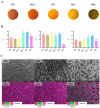Quantitative Lipidome Analysis of Boiled Chicken Egg Yolk under Different Heating Intensities
- PMID: 37375157
- PMCID: PMC10301504
- DOI: 10.3390/molecules28124601
Quantitative Lipidome Analysis of Boiled Chicken Egg Yolk under Different Heating Intensities
Abstract
The effects of the four heating intensities (hot-spring egg yolk, HEY; soft-boiled egg yolk, SEY; normal-boiled egg yolk, NEY; and over-boiled egg yolk, OEY) on lipidomes of boiled egg yolks were investigated. The results indicated that four heating intensities had no significant effect on the total abundance of lipids and lipid categories except for bile acids, lysophosphatidylinositol, and lysophosphatidylcholine. However, of all the 767 lipids quantified, the differential abundance of 190 lipids was screened among the egg yolk samples at four heating intensities. Soft-boiling and over-boiling altered the assembly structure of the lipoproteins through thermal denaturation and affected the binding of lipids and apoproteins, resulting in an increase in low-to-medium-abundance triglycerides. The decreased phospholipid and increased lysophospholipid and free fatty acid in HEY and SEY suggests potential hydrolysis of phospholipids under relatively low-intensity heating. Results provide new insights into the effect of heating on the lipid profiles of egg yolk and would support the public's choice of cooking method for egg yolks.
Keywords: egg yolk; heating; lipidome; phospholipids; triglycerides.
Conflict of interest statement
The authors declare that they have no known competing financial interest or personal relationships that could have appeared to influence the work reported in this paper.
Figures








References
-
- Asensio-Grau A., Peinado I., Heredia A., Andrés A. Effect of cooking methods and intestinal conditions on lipolysis, proteolysis and xanthophylls bioaccessibility of eggs. J. Funct. Foods. 2018;46:579–586. doi: 10.1016/j.jff.2018.05.025. - DOI
-
- Tang X., Meng X., Wang H., Wang T., Li Q., Jiang S. Egg allergy was alleviated after baking and frying cooking by weakening Jagged2-Notch induced Th2 immunity in a mice model. Eur. Food Res. Technol. 2022;248:917–927. doi: 10.1007/s00217-021-03938-0. - DOI
MeSH terms
Substances
Grants and funding
LinkOut - more resources
Full Text Sources

